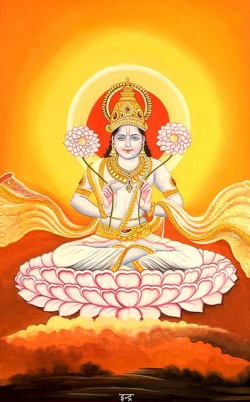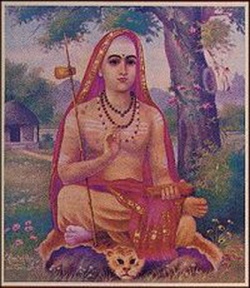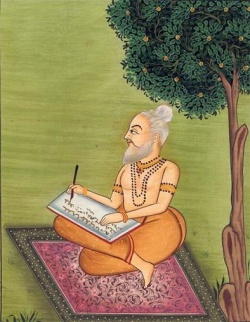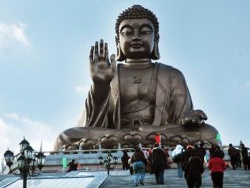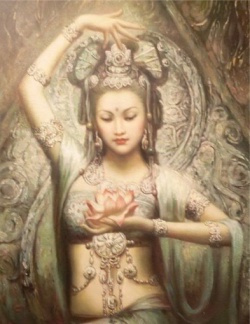Difference between revisions of "Avadhuta"
(Created page with "thumb|250px|thumb|250px|thumb|250px|thumb|250px|File:Ddha-statue.jpg|thumb|2...") |
|||
| Line 1: | Line 1: | ||
[[File:12 Adityas.jpg|thumb|250px|]][[File:8 5278303 n.jpg|thumb|250px|]][[File:Adi Shankara02.jpg|thumb|250px|]][[File:Ayana1.jpg|thumb|250px|]][[File:Ddha-statue.jpg|thumb|250px|]][[File:Deity58.jpg|thumb|250px|]] | [[File:12 Adityas.jpg|thumb|250px|]][[File:8 5278303 n.jpg|thumb|250px|]][[File:Adi Shankara02.jpg|thumb|250px|]][[File:Ayana1.jpg|thumb|250px|]][[File:Ddha-statue.jpg|thumb|250px|]][[File:Deity58.jpg|thumb|250px|]] | ||
| − | [[Avadhuta]] ({{SanskritBig|[[अवधूत]]}} [[avadhūta]]) is a [[Sanskrit]] term from some [[Indian]] [[religions]] or | + | [[Avadhuta]] ({{SanskritBig|[[अवधूत]]}} [[avadhūta]]) is a [[Sanskrit]] term from some [[Indian]] [[religions]] or Dharmic Traditions referring to a type of [[mystic]] or [[saint]] who is beyond egoic-consciousness, [[duality]] and common [[worldly]] concerns and acts without [[consideration]] for standard {{Wiki|social}} {{Wiki|etiquette}}. Such personalities "roam free like a child upon the face of the [[Earth]]". An [[avadhuta]] does not identify with their [[mind]] or [[body]] or 'names and [[forms]]' ([[Sanskrit]]: [[namarupa]]). Such a [[person]] is held to be [[pure]] '[[consciousness]]' ([[Sanskrit]]: [[caitanya]]) in [[human]] [[form]]. |
[[Avadhuts]] play a significant role in the history, origins and rejuvenations of a number of [[Dharmic Traditions]] such as [[Yoga]], [[Vedanta]], [[Buddhadharma]] and [[Bhakti]] '[[lineage]]' ([[Sanskrit]]: [[parampara]]) even as they are released from standard observances. [[Avadhuts]] are the {{Wiki|voice}} of the [[avadhuti]] the [[channel]] that resolves the {{Wiki|dichotomy}} of the '[[left hand path]]' ([[Sanskrit]]: [[Vamamarga]]; "[[Vamachara]]") and '[[right hand path]] ([[Sanskrit]]: [[Dakshinamarga]]) [[traditions]] and left and right channels (otherwise known as the outer channels) of the energetic [[body]], though an [[Avadhut]] may or may not continue such dichotomous [[rites]] of the [[Wikipedia:Āstika and nāstika|āstika or nāstika]] [[Darśana]] for they are free from {{Wiki|sectarian}} [[ritual]] [[observance]] and affiliation. | [[Avadhuts]] play a significant role in the history, origins and rejuvenations of a number of [[Dharmic Traditions]] such as [[Yoga]], [[Vedanta]], [[Buddhadharma]] and [[Bhakti]] '[[lineage]]' ([[Sanskrit]]: [[parampara]]) even as they are released from standard observances. [[Avadhuts]] are the {{Wiki|voice}} of the [[avadhuti]] the [[channel]] that resolves the {{Wiki|dichotomy}} of the '[[left hand path]]' ([[Sanskrit]]: [[Vamamarga]]; "[[Vamachara]]") and '[[right hand path]] ([[Sanskrit]]: [[Dakshinamarga]]) [[traditions]] and left and right channels (otherwise known as the outer channels) of the energetic [[body]], though an [[Avadhut]] may or may not continue such dichotomous [[rites]] of the [[Wikipedia:Āstika and nāstika|āstika or nāstika]] [[Darśana]] for they are free from {{Wiki|sectarian}} [[ritual]] [[observance]] and affiliation. | ||
| Line 8: | Line 8: | ||
'ava' ({{Wiki|Devanagari}}: {{SanskritBig|[[अव]]}}): | 'ava' ({{Wiki|Devanagari}}: {{SanskritBig|[[अव]]}}): | ||
| − | # [{{Wiki|masculine}} [[gender]]] favour (as per usage in ऋग्-वेद i, 128, 5) | + | # [ {{Wiki|masculine}} [[gender]]] favour (as per usage in ऋग्-वेद i, 128, 5) |
# [indeclinable] (as a prefix to verbs and [[verbal]] nouns expresses) and holds the {{Wiki|semantic field}}: off, away, down. | # [indeclinable] (as a prefix to verbs and [[verbal]] nouns expresses) and holds the {{Wiki|semantic field}}: off, away, down. | ||
| Line 15: | Line 15: | ||
'dhUta' ({{Wiki|Devanagari}}: {{SanskritBig|[[धूत]]}}): | 'dhUta' ({{Wiki|Devanagari}}: {{SanskritBig|[[धूत]]}}): | ||
| − | # [{{Wiki|masculine}}, {{Wiki|feminine}} and neuter; or adjective] shaken, stirred, agitated (सोम = धौत "rinsed" as in the text साम-वेद) | + | # [ {{Wiki|masculine}}, {{Wiki|feminine}} and neuter; or adjective] shaken, stirred, agitated (सोम = धौत "rinsed" as in the text साम-वेद) |
# fanned, kindled | # fanned, kindled | ||
# shaken off, removed, destroyed | # shaken off, removed, destroyed | ||
# judged | # judged | ||
# reproached | # reproached | ||
| − | # | + | # [ neutral [[gender]]] [[morality]] ([[Buddhist]] {{Wiki|literature}}) |
===Ava–Dhuta=== | ===Ava–Dhuta=== | ||
Revision as of 06:04, 14 December 2013
Avadhuta (अवधूत avadhūta) is a Sanskrit term from some Indian religions or Dharmic Traditions referring to a type of mystic or saint who is beyond egoic-consciousness, duality and common worldly concerns and acts without consideration for standard social etiquette. Such personalities "roam free like a child upon the face of the Earth". An avadhuta does not identify with their mind or body or 'names and forms' (Sanskrit: namarupa). Such a person is held to be pure 'consciousness' (Sanskrit: caitanya) in human form.
Avadhuts play a significant role in the history, origins and rejuvenations of a number of Dharmic Traditions such as Yoga, Vedanta, Buddhadharma and Bhakti 'lineage' (Sanskrit: parampara) even as they are released from standard observances. Avadhuts are the voice of the avadhuti the channel that resolves the dichotomy of the 'left hand path' (Sanskrit: Vamamarga; "Vamachara") and 'right hand path (Sanskrit: Dakshinamarga) traditions and left and right channels (otherwise known as the outer channels) of the energetic body, though an Avadhut may or may not continue such dichotomous rites of the āstika or nāstika Darśana for they are free from sectarian ritual observance and affiliation.
Ava
'ava' (Devanagari: अव):
- [ masculine gender] favour (as per usage in ऋग्-वेद i, 128, 5)
- [indeclinable] (as a prefix to verbs and verbal nouns expresses) and holds the semantic field: off, away, down.
Dhuta
'dhUta' (Devanagari: धूत):
- [ masculine, feminine and neuter; or adjective] shaken, stirred, agitated (सोम = धौत "rinsed" as in the text साम-वेद)
- fanned, kindled
- shaken off, removed, destroyed
- judged
- reproached
- [ neutral gender] morality (Buddhist literature)
Ava–Dhuta
'avadhUta' (Devanagari: अवधूत):
- अव-धूत "shaken off (as evil spirits)" as in the text वाजसनेयि-संहिता
- removed, shaken away
- discarded, expelled, excluded
- disregarded, neglected, rejected
- touched
- shaken, agitated (especially as plants or the dust by the wind), fanned
- that upon which anything unclean has been shaken out or off
- unclean
- one who has shaken, off from themselves worldly feeling and obligation, a philosopher
- [neuter gender] rejecting, repudiating
SYLLABLE wise explanation of A-VA-DHOO-TA
A- the letter A of Avadhoot signifies freedom from bondage of desire and purity in all 3 Dimesnsions and times i.e. past present and future and infinite bliss.
VA- Stands for one who resides in present without any botheration about the past and future i.e. one whose broken the shackles of Karma Vasana.
DHOO- Stands for complete mastery over mind and body and freedom from all malas ( Karmika, Mayaika etc.)
TA- Stands for constant contemplation of ATTMA TATTVA i.e. delving into Agya chakra and ultimately your higher self. Also it symbolizes liberation from tamas and resulting atamkar.
Types of Avadhutas
Feuerstein (1991: p. 105) frames how the term 'Avadhuta' came to be associated with the mad or eccentric holiness or 'crazy wisdom' of some antinomian paramahamsa who were often 'skyclad' or 'naked' (Sanskrit: digambara):
- "The appellation "avadhuta," more than any other, came to be associated with the apparently crazy modes of behaviour of some paramahamsas, who dramatize the reversal of social norms, a behaviour characteristic of their spontaneous lifestyle. Their frequent nakedness is perhaps the most symbolic expression of this reversal."
Sacrifice
Chandra et al.. (1902: p. 20) equates the 'chodpa' (Tibetan: གཅོད་པ, Wylie: chod pa) as a type of avadhuta:
- "ཀུ་སུ་ལུ་པ ku-su-lu-pa is a word of Tantrik mysticism, its proper Tibetan equivalent being གཅོད་པ, the art of exorcism. The mystic Tantrik rites of the Avadhauts, called Avadhūtipa in Tibet, exist in India."
The rites of chod differ between lineages but essentially there is an offering of their body as food, a blessing to demons and other entities to whom this kind of offering may be of benefit. This leitmotif and sadhana is common to another denizen of the charnel ground, Dattatreya the avadhuta, to whom has been attributed the esteemed nondual medieval song, the Avadhuta Gita. Dattatreya was a founding adi guru of the Aghor tradition according to Barrett (2008: p. 33):
- "...Lord Dattatreya, an antinomian form of Shiva closely associated with the cremation ground, who appeared to Baba Kina Ram atop Girnar Mountain in Gujarat. Considered to be the adi guru (ancient spiritual teacher) and founding deity of Aghor, Lord Dattatreya offered his own flesh to the young ascetic as prasād (a kind of blessing), conferring upon him the power of clairvoyance and establishing a guru-disciple relationship between them."
Mahānirvāṇatantraṃ
Woodroffe, in his translation of the Mahānirvāṇatantraṃ from the original Sanskrit into English under his nom-de-plume of Arthur Avalon, may be the opening discourse of the archetype of "Avadhuta" to the English reading public, as none of the Avadhuta upanishads were translated amongst the collections of minor upanishads such as the Thirty Minor Upanishads (Aiyar: 1914). The pen-name is play on the magical realm of Avalon and the young later-to-be, King Arthur, within the story-cycle of tales known generally as King Arthur and the Knights of the Round Table; specifically according to Taylor (2001: p. 148), Woodroffe chose the name from the noted incomplete magnum opus, the painting 'Arthur's Sleep in Avalon' by Burne-Jones. Moreover, Taylor (2001: p. 148) conveys the salience of this magical literary identity and contextualizes by making reference to western esotericism, Holy grail, quest, occult secrets, initiations and the Theosophists:
- "This is quite important to know, for here we have a writer on an Indian esoteric system taking a name imbued with western esotericism. The name at any rate seems to hint at initiations and the possession of occult secrets. The Arthurian legends are bound up with the story of the Holy Grail and its quest. This was a symbol of esoteric wisdom, especially to Theosophists who appropriated the legend. Anyone who named himself after King Arthur or the mystic isle of Avalon would be thought to be identifying himself with occultism, in Theosophists' eyes."
Unfortunately, the most important point is not made by Taylor (2001: p. 148) and that is of the Eternal return (of "the once and future King") a narrative, motif and archetype that pervades the two traditions of entwined esotericism, East and West.
The Mahānirvāṇatantraṃ is an example of a nondual tantra and the translation of this work had a profound impact on the Indologists of the early to mid 20th century. The work is notable for many reasons and importantly mentions four kinds of Avadhuta.
Brahmanirvantantra
The book of Brahmanirvantantra describes how to identify the avadhuts of the following types:
- Bramhavadhuta : An avadhut from birth, who appears in any class of society. Completely indifferent to the world or worldly matters.
- Shaivavadhuta : Avadhuts who have taken to the renounced order of life (sannyas), often with unkempt long hair (jata), or who dress in the manner of Shaivites and spend almost all of their time in trance (samādhi), or meditation.
- Viravadhuta : This person looks like a sadhu who has put red colored sandal paste on his body and wears saffron clothes. His hair are very well grown and are normally furling in the wind. They wear in their neck a Rudraksha mala or a string with bones. They hold a wooden stick (danda) in their hand and additionally they always have an axe (parashu) or a damaru (small drum) with them.
- Kulavadhuta : These people are supposed to have taken initiation from the Kaula sampradaya. It is very difficult to recognize these people as they do not wear any signs outside which can identify them from others. The speciality of these people is that they remain and live like usual people do. They can show themselves in the form of Kings or a family man.
There is one type of Avadhuta Sect which has their worship samadhi located at Karla (near Amaravati in Maharashtra), this sect has followers in Vidharba, they do puja of samadhi at home also, they are against murthi puja and their greeting style is different from others, they greet by closing hand like doing namaskara and then touching each other's hand. They are against murthi puja and they call their worship house (temple) as Bangala. They have typical tradition of burying bodies after death and not burning it like other Hindus do. They do not have idols of any god or do not go to any other temples of Hindus. they held typical bhajans which are different from any other bajans prevalent in local Hindu population. Also during prayer they stand still in front of samadhi until the kapur is lit off naturally after it is burnt. Followers of this sect are Shids (some converted their name to Shinde from Savali near wardha) Relationship with the Nath sampradaya
The Nath Sampradaya is a form of Avadhuta-pantha (sect). In this sampradaya, Guru-importance and Yoga are of extreme importance. Therefore the most important book in this sampradaya is Avadhut Gita. Shri Gorakshanath is considered the topmost form of Avadhut-state.
The nature of the avadhuta is the subject of the Avadhuta Gita, the authorship of which is traditionally ascribed to Dattatreya.
Books
- Siddha Siddhanta Paddhati is a very early extant Hatha Yoga Sanskrit text attributed to Gorakshanath by the indigenous tradition, as Feuerstein (1991: p. 105) relates:
- "One of the earliest hatha yoga scriptures, the Siddha Siddhanta Paddhati, contains many verses that describe the avadhuta. One stanza (VI.20) in particular refers to his chameleon-like capacity to animate any character or role. At times, it is said, he behaves like a worldling or even a king, at other times like an ascetic or naked renunciant."
- Jayachamaraja Wodeyar Bahadur's (1919–1974) Avadhuta: Reason & Reverence, Indian Institute of World Culture?, Bangalore, 1958.
- Avadhuta Upanishad is 79th book of the Muktika canon of Upanishads. It is a Sannyasa Upanishad associated with the Black Yajurveda.
- According to the International Nath Order of the Nath Sampradaya, the Avadhuta Gita is a text of Advaita Vedanta sung by Dattatreya and recorded by his disciples Swami and Kartika.
- Avadhutaka Upanishad, one of the 108 principal Upanishad.
Avadhutas (the "pure ones", in Bhagavat Purana 4.29.11 described as "most free") are usually associated with the Shaivite tradition but there is a relatively obscure lineage of Vaishnava sannyasis known as turiyatit-avadhuta. The turiyatit-avadhuta are described in the Narada-parivrajaka-upanisad, Turiyatit-avadhuta-upanisad and the Brhad-avadhuta-upanisad."
- Narada-parivrajaka-upanisad
- Bṛhad Avadhūta Upaniṣad— Rigopoulos (1998: p. 214) renders the Bṛhad Avadhūta Upaniṣad 1.2, a text oriented to the Vaishnava tradition, thus:
- "The Avadhūta is so called because he is immortal (akṣara); he is the greatest (vareṇya); he has discarded worldly ties (dhūta-saṃsāra-bandhana); and he is indicated in the meaning of the sentence "Thou art That," etc. (tat-tvam-asyādi-lakṣya)."
